Eight Steps of an RSA
The eight steps of an RSA are shown in Figure 1, and are discussed below with some reference to the case studies.
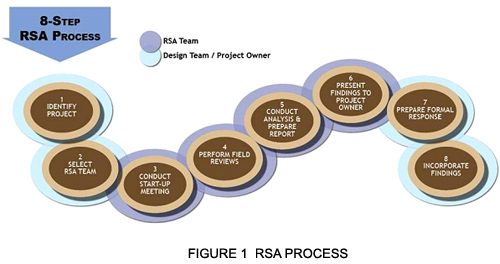
RSA projects and the RSA Team (Steps 1 and 2) were pre-selected in this FHWA case studies project. RSA teams were interdisciplinary, typically including engineering and enforcement staff. Some RSA teams included non-traditional disciplines that were beneficial to the team, such as the public health specialist from Indian Health Services (IHS) who played a critical role in the Red Mesa RSA for the Navajo Nation.
All meetings and site visits for the RSAs in the case studies project were conducted over two or three day periods. The RSAs typically began with a start-up meeting (Step 3) attended by the Project Owner and/or Design Team (hereafter referred to as the Owner), and the RSA team:
- The Owner described concerns regarding the roads and intersections to be assessed, why the sites had been chosen for an RSA, and any constraints or limitations. Typically, the reasons for the RSA site selection centered on high-profile crashes or public safety concerns.
- The multidisciplinary RSA Team then described the RSA process. This included an overview of the RSA process with examples of safety issues that are typically encountered and mitigation measures to address them.
- Additional issues can be discussed during this step. For example, at the Red Cliff RSA, which included a review of planned improvements, the Design Team representative described the proposed future road design, including its constraints and challenges.
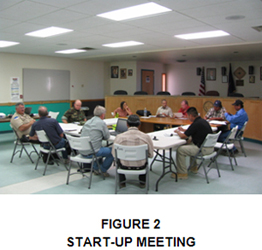 |
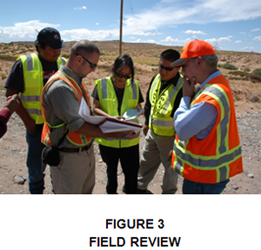 |
Following the start-up meeting and a preliminary review of the design or site documentation, the RSA Team conducted a field review (Step 4). The purpose of the field review was to observe the ambient conditions in which the proposed design would operate (for the planning-stage RSA), or to observe geometric and operating conditions (for the RSAs of existing roads). The RSA Team observed site characteristics (such as road geometry, sight distances, clear zones, drainage, signing, lighting, and barriers), traffic characteristics (such as typical speeds and traffic mix), surrounding land uses (including traffic and pedestrian generators), and link points to the adjacent transportation network. Human factors issues were also considered by the RSA team, including road and intersection “readability,” sign location and sequencing, and older-driver limitations. Field reviews were conducted by the RSA Team under a variety of environmental conditions (such as daytime and night-time) and operational conditions (such as peak and off-peak times).
The team conducted the RSA analysis (Step 5) in a setting in which all team members reviewed available background information (such as traffic volumes and collision data) in light of the observations made in the field. On the basis of this review, the RSA Team identified and prioritized safety issues, including features that could contribute to a higher frequency and/or severity of crashes. For each safety issue, the RSA Team generated a list of possible measures to mitigate the crash potential and/or severity of a potential crash.
At the end of the analysis session, the Owner and RSA Team reconvened for a preliminary findings meeting (Step 6). Presenting the preliminary findings verbally in a meeting gave the Owner the opportunity to ask questions and seek clarification on the RSA findings, and also provided a useful forum for the Owner to suggest additional or alternative mitigation measures in conjunction with the RSA team. The discussion provided practical information that was subsequently used to write the RSA report.
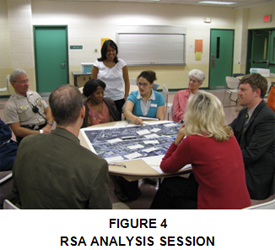 |
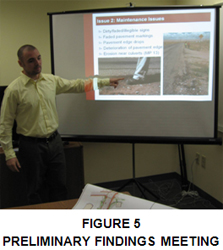 |
In the weeks following the on-site portion of the RSA, the RSA Team wrote and issued the RSA report (also part of Step 6) to the Owner documenting the results of the RSA. The main content of the RSA report was a prioritized listing and description of the safety issues identified (illustrated using photographs taken during the site visit), with suggestions for improvements.
The Owner was encouraged to write a brief response letter (Step 7) containing a point-by-point response to each of the safety issues identified in the RSA report. The response letter identifies the action(s) to be taken, or explains why no action would be taken. The formal response letter is an important “closure” document for the RSA. As a final step, the Owner was encouraged to use the RSA findings to identify and implement safety improvements when policy, manpower, and funding permit (Step 8).
Prioritization of Issues
For many of the RSAs conducted on FLMAs and tribal lands, reliable crash data were not available. Anecdotal information on run off the road crashes and evidence of fence strikes along the roadway helped create a more complete picture of the potential hazards, but could not be quantified with any certainty. Therefore a prioritization framework was applied in both the RSA analysis and presentation of findings. The likely frequency and severity of crashes associated with each safety issue were qualitatively estimated, based on team members’ experience and expectations. Expected crash frequency was qualitatively estimated on the basis of expected crashes, exposure (how many road users would likely be exposed to the identified safety issue?) and probability (how likely was it that a collision would result from the identified issue?). Expected crash severity was qualitatively estimated on the basis of factors such as anticipated speeds, expected collision types, and the likelihood that vulnerable road users would be exposed. These two risk elements (frequency and severity) were considered during the qualitative risk assessment of each safety issue on the basis of the matrix shown in Table 2.
Consequently, the RSA Team prioritized each safety issue. It should be stressed that this prioritization method was qualitative, based on the expectations and judgment of the RSA Team members, and was employed to help the Owner prioritize the multiple issues identified in the RSA. For each safety issue identified, possible mitigation measures were suggested for short-term, intermediate, and long-term implementation timeframes. The suggestions focused on short-term and intermediate measures that could be cost-effectively implemented within likely budget constraints. Ultimately, implementation of the measures suggested in the RSA is dependent on project costs and financial constraints of the Owner.
FREQUENCY RATING |
SEVERITY RATING | |||
| Minor | Moderate | Serious | Fatal | |
| Frequent | Moderate-High | High | Highest | Highest |
| Occasional | Moderate | Moderate-High | High | Highest |
| Infrequent | Low | Moderate | Moderate-High | High |
| Rare | Lowest | Low | Moderate | Moderate-High |
